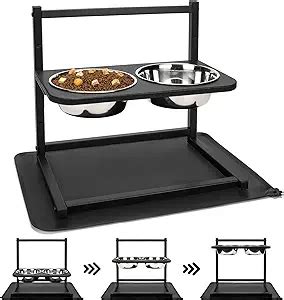1. What is an Elevated Dog Bowl?
Elevated dog bowls are specifically designed to raise your dog’s food and water dishes from the ground, providing numerous benefits for their health and comfort.

2. Why Choose an Elevated Dog Bowl?
- Improved Digestion: Raising the bowls to the level of your dog’s chest aids in the flow of food and water, reducing the risk of bloat and other digestive issues.
- Reduced Strain: Elevated bowls alleviate strain on your dog’s neck and joints, making mealtime more comfortable, especially for large or aging dogs.
- Better Posture: By elevating the bowls, dogs are less likely to hunch or bend their necks, promoting good posture and preventing spinal problems.
- Hygienic: Off-the-ground bowls prevent food and water from coming into contact with dirt, dust, or insects, reducing contamination risks.
3. What are the Different Types of Elevated Dog Bowls?
Single Bowl vs. Double Bowl:
- Single bowls: Designed for food or water only.
- Double bowls: Provide separate compartments for both food and water.
Adjustable vs. Non-Adjustable:
- Adjustable bowls: Allow customization of the height to suit your dog’s needs.
- Non-adjustable bowls: Offer a fixed height.
Material Types:
- Stainless steel: Durable and easy to clean.
- Ceramic: Stylish and heavy-weight, preventing spills.
- Plastic: Lightweight and affordable, but may not be as durable.
4. How High Should an Elevated Dog Bowl Be?
The ideal height of an elevated bowl varies based on your dog’s size:
- Small dogs: 3-6 inches
- Medium dogs: 6-10 inches
- Large dogs: 10-14 inches
5. How to Choose the Right Elevated Dog Bowl
- Size: Consider your dog’s height and breed.
- Material: Choose a material that suits your needs and budget.
- Type: Single or double bowls can meet different preferences.
- Adjustability: Adjustable bowls provide flexibility as your dog grows.
- Stability: Ensure the bowl is stable and won’t tip over easily.
6. Benefits vs. Drawbacks of Elevated Dog Bowls
Benefits:
- Improved digestion
- Reduced strain
- Better posture
- Hygienic
Drawbacks:
- Can be more expensive than regular bowls
- May require adjusting for different breeds
- Some dogs may prefer eating on the ground
7. FAQ on Elevated Dog Bowls
Q: Are elevated dog bowls better for dogs with joint pain?
A: Yes, elevated bowls can alleviate strain on joints, making mealtime more comfortable for dogs with arthritis or mobility issues.
Q: Can I use an elevated bowl for my puppy?
A: Yes, elevated bowls can be beneficial for puppies by preventing them from hunching over and promoting good posture.
Q: What if my dog refuses to use an elevated bowl?
A: Gradually introduce the bowl and make it more appealing by gradually adjusting the height or placing treats inside.
Q: Can I make my own elevated dog bowl?
A: Yes, you can DIY an elevated bowl using a variety of materials, such as cinder blocks, PVC pipes, or wooden crates.
8. Current Status and Future Innovations
Elevated dog bowls have gained popularity due to their numerous benefits for dogs’ health and comfort. Future innovations may include:
- Smart bowls: Bowls that track food and water intake, providing insights into a dog’s diet and hydration.
- Ergonomic designs: Bowls designed to optimize comfort and safety for dogs with specific needs.
- Personalized feeders: Bowls that can be customized to meet the dietary requirements and preferences of each dog.
9. Case Detail: Elevated Bowl for Senior Dogs
Case: A 10-year-old golden retriever named Max was experiencing difficulty eating and drinking due to arthritis in his neck and joints.
Solution: Max’s owner switched to an adjustable elevated dog bowl, which reduced strain on his joints and made mealtime more comfortable.
Outcome: Max’s digestion improved, his pain was reduced, and his overall quality of life improved significantly.
10. Conclusion
Elevated dog bowls are a simple but effective way to enhance the health and well-being of your furry companion. By choosing the right elevated bowl for your dog’s needs, you can promote improved digestion, reduce strain, promote good posture, and maintain a hygienic environment for their meals.





















